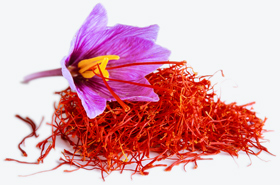

Saffron is a spice of very ancient origins. In the past it was valued for its gastronomical properties and often utilised for therapeutic purposes. Frescoes over approximately 3000 years old, witness the use of the Saffron stigmas in Ancient Greece. However, it was in the Roman Period in which Saffron reached its highest level of notoriety. Thereby, becoming a symbol of wealth and preciousness, with which the privileged classes displayed their richness.
In Medieval Times, Saffron was widely utilised for curative reasons. Recent scientific discoveries have infact confirmed what was previously ascertained by folklore traditions, that Saffron is a strong natural antioxidative, in addition to being a product with refined culinary properties.

The cultivation and conservation of Saffron is a laborious and complex art, based on an artisan method. It should be noted that to obtain 1 kg of raw material, approximately 150.000 flowers are necessary. These plants grow in particular climatic conditions, that is hot and humid in the Summer and cold in the Winter, with only a slight variation in aroma and taste, according to where the product is cultivated. The flowering period normally lasts 18 days. Furthermore, very important in terms of quality is the harvesting and the care taken in the perservation of the stigma.
The harvesting is effected at dawn, before the flower opens up and subsequently, the Saffron undergoes a drying procedure in electrically ventilated ovens placed in hermetically sealed containers, sheltered from the light, in order to preserve aroma and taste. The quality of the product is based on certain chemical - physic parameters, such as "Pirocrocina" which identifies the bitterness potential, the characteristic bitter taste, and the "Crocina" that determines the colour capacity. The intensity of the odour is attributed to "Safranale".
Generally, when the product is foreseen for large Supermarkets, it is commercialised in powder form, for pratical reasons, and additionally for a better yield, in terms of taste and colour.
Saffron is an alimentary ingredient with extraordinary qualitative characteristics, abounding in vitamins, mineral salts, antioxidants and is classified as a medicinal herb by The Official Italian Pharmacopea, in virtue of its capacity to eliminate the unwanted substances produced by our organism, responsible for the natural process of deterioration.

 English (United Kingdom)
English (United Kingdom)  Italiano (Italia)
Italiano (Italia) 